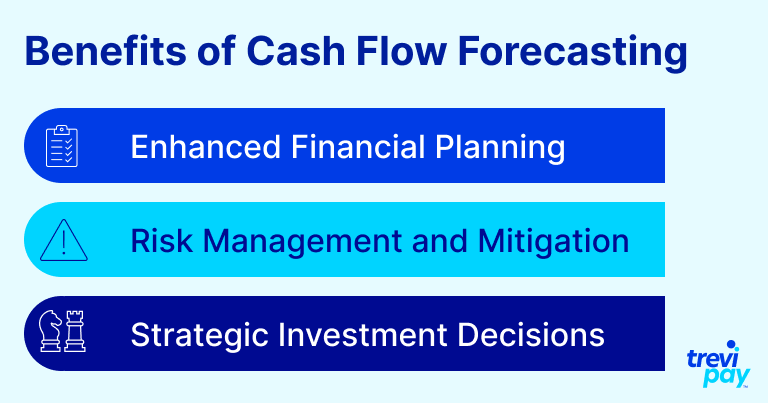IIn the dynamic world of business finance, cash flow forecasting is a cornerstone of effective financial management. This process predicts future cash flow, showing how much money will come in and go out. This helps businesses understand their finances and the challenges they might face.
Cash flow forecasts are important for businesses. They help navigate market changes, economic uncertainties, and growth opportunities. By effectively predicting their cash flow, companies can stay stable, grow and make smart choices. But what is a cash flow forecast in the first place? In this blog, we will explore the intricacies of cash flow forecasting and its pivotal role in driving business success.
What is Cash Flow Forecasting?
Cash flow forecasting is estimating a business’s future financial position by projecting the expected cash inflows and outflows over a period of time, usually on a monthly or quarterly basis. The purpose of cash flow forecasting is to ensure that a company maintains sufficient liquidity to meet its financial obligations and capitalize on growth opportunities. In other words, it helps predict what cash on hand a business will have in its bank account.
Cash flow goes beyond simple profit calculations to provide a real-time view of a company’s financial health. It helps to prevent cash shortages. Low cash on hand leads to missed payments, damaged relationships with suppliers, and/or missed opportunities for expansion.
Unlike broader financial projections such as income statements or balance sheets, which focus on overall profitability or asset valuation, cash flow forecasting specifically targets the timing and amount of actual cash entering and exiting the business. This detailed, time-sensitive view of cash availability is crucial for effective day-to-day operations and short to medium-term planning.
Accurate cash flow forecasts are essential in preventing cash-on-hand issues that can cripple even profitable businesses. By anticipating cash shortfalls or surpluses, companies can take proactive measures to manage their accounts receivable days, ensuring a steady flow of cash.
Benefits of Cash Flow Forecasting
Cash flow forecasting offers many benefits that extend far beyond basic financial planning. At its core, it empowers businesses to make informed decisions, manage risks effectively, and seize strategic opportunities.
Firstly, cash flow forecasting significantly enhances financial planning. A clear view of future cash positions allows businesses to budget more accurately and plan for both short-term operations and long-term investments. This improved planning capability helps align financial resources with broader business goals, ensuring that capital is available when needed for critical initiatives.
Secondly, cash flow forecasting is a powerful tool for risk management. It helps businesses identify potential financial challenges before they become critical, enabling them to take proactive measures. This could involve securing additional financing, adjusting payment terms with suppliers, or implementing cost-cutting measures. By forecasting cash flow gaps, companies can avoid the stress and potential damage caused by unexpected shortfalls.
Lastly, accurate forecasts support strategic decision-making by providing a solid foundation for investment decisions and growth strategies. They help businesses determine the optimal timing for major expenditures, expansions, or new product launches.
Moreover, effective cash flow management, supported by accurate forecasting, can significantly impact a company’s financial health. For instance, managing Days Sales Outstanding (DSO) effectively can improve overall cash flow, reinforcing the importance of integrating cash flow forecasting with broader financial management strategies.

Enhanced Financial Planning
Cash flow forecasting serves as the backbone of robust financial planning and budgeting processes. By providing a detailed projection of cash inflows and outflows, it enables businesses to create more realistic budgets. This level of insight allows companies to:
- Anticipate periods of cash surplus or deficit, facilitating proactive resource allocation
- Identify potential timing mismatches between income and expenses
- Set more achievable financial targets based on projected cash availability
- Adjust spending plans to maintain adequate liquidity throughout the year
- Plan for major expenditures or investments by ensuring sufficient cash will be available
Furthermore, cash flow forecasting plays a crucial role in aligning financial resources with business goals. It provides the visibility needed to:
- Prioritize spending on strategic initiatives that align with long-term objectives
- Identify opportunities for reinvestment in growth areas when cash surpluses are projected
- Make informed decisions about the timing of major projects or expansions
- Determine optimal timing for raising capital or seeking financing to support business goals
- Balance short-term operational needs with long-term strategic investments
This alignment ensures that financial resources are deployed effectively to support the company’s overall strategy and goals, rather than being reactive to short-term cash flow pressures.
Risk Management and Mitigation
Cash flow forecasting is an invaluable tool for identifying and mitigating potential financial risks. By projecting future cash positions, businesses can anticipate and prepare for various financial challenges, including:
- Seasonal fluctuations in revenue or expenses
- Unexpected market downturns or economic recessions
- Changes in customer payment behaviors
- Sudden increases in operational costs
Armed with this foresight, companies can implement risk mitigation strategies such as:
- Building cash reserves during projected surplus periods
- Negotiating flexible payment terms with suppliers
- Diversifying revenue streams to reduce reliance on a single market or customer
- Implementing cost-cutting measures in anticipation of lean periods
Moreover, cash flow forecasting helps businesses prepare for broader market fluctuations and economic downturns. By running multiple forecast scenarios based on different economic conditions, companies can develop contingency plans and maintain financial stability even in challenging times.
Strategic Investment Decisions
Accurate cash flow forecasts are instrumental in informing and supporting strategic investment decisions. They provide a clear picture of when and how much cash will be available for investments, allowing businesses to:
- Determine the optimal timing for major capital expenditures
- Evaluate the feasibility of expansion plans or new product launches
- Assess the impact of potential acquisitions or mergers on cash flow
- Decide on the most appropriate financing options for large investments
Furthermore, cash flow forecasting impacts capital allocation and resource management by:
- Highlighting areas where resources may be underutilized or over-allocated
- Identifying opportunities to redirect cash to more profitable ventures
- Supporting decisions on dividend payments or share buybacks
- Guiding working capital management strategies
By providing a comprehensive view of future cash availability, forecasting enables businesses to make investment decisions that align with their financial capabilities and strategic objectives.
How to Forecast Cash Flow
Developing an accurate cash flow forecast involves a systematic approach that combines historical data analysis with forward-looking projections. Here is a step-by-step process:
- Define the forecast period (e.g., monthly for the next 12 months)
- Gather historical financial data, including sales, expenses, and cash flow statements
- Identify and categorize all sources of cash inflows (e.g., sales, investments, loans)
- List all expected cash outflows (e.g., operating expenses, loan repayments, taxes)
- Project future inflows and outflows based on historical trends and known future events
- Consider timing differences between when sales occur and when cash is received
- Account for seasonality and any expected changes in business conditions
- Create multiple scenarios (best case, worst case, and most likely) to account for uncertainties
- Regularly update and refine the forecast as new information becomes available
Collecting Financial Data
The cash flow forecast typically includes line items for cash receipts (e.g., sales, collections, financing) and cash disbursements (e.g., supplier payments, payroll, capital expenditures, loan repayments).
Key components needed for an accurate forecast include:
- Sales projections
- Accounts receivable and account payable schedules
- Inventory levels and purchasing plans
- Capital expenditure plans
- Debt repayment schedules
- Tax obligations
Gathering comprehensive and accurate financial data is crucial for creating reliable cash flow forecasts. This process involves several key steps:
- Extracting data from accounting systems and financial statements,
- Collecting information on pending sales and purchase orders,
- Reviewing contracts for recurring revenue or expenses, and
- Analyzing historical cash flow patterns.
By compiling this information, businesses can build a solid foundation for their cash flow projections. This foundation ensures their forecasts rely on the most up-to-date and relevant financial data.
When identifying and categorizing income and expenses, consider:
- Breaking down revenue by product line, customer segment, or geographic region
- Categorizing expenses into fixed and variable costs
- Separating operational expenses from capital expenditures
- Accounting for non-cash items like depreciation and amortization
Various tools and software can assist in the data collection and reduce errors for cash flow forecasting. These include popular accounting software like QuickBooks and Xero, which provide detailed financial records and reports. Enterprise Resource Planning (ERP) systems offer comprehensive business management solutions that integrate various aspects of operations, including financials. Customer Relationship Management (CRM) tools can provide valuable insights into sales pipelines and customer payment behaviors.
Additionally, specialized cash flow forecasting software streamlines the forecasting process and provides advanced analytical capabilities. By leveraging technology, businesses can automate data collection, reduce errors, and gain more timely insights into their cash flow patterns and projections.
Analyzing and Projecting Cash Flow
Once the financial data is collected, the next step is to analyze current cash flow patterns and project future trends. This involves:
- Identifying trends and patterns in historical cash flow data
- Adjusting for known future changes (e.g., new contracts, planned investments)
- Applying growth rates based on market conditions and company strategy
- Accounting for seasonal fluctuations
When creating projections, it is important to use different scenarios and assumptions to account for uncertainties. This might include:
- Best-case scenario: Assuming optimal market conditions and business performance
- Worst-case scenario: Accounting for potential market downturns or operational challenges
- Most likely scenario: Based on the most probable outcomes given current information
Businesses should be prepared to adjust their forecasts based on changing conditions. The dynamic nature of business environments means that assumptions and projections need to be flexible and responsive to new information and events.
For example, if a major customer delays payments, it is crucial to adjust the accounts receivable projections accordingly. This ensures that the forecast accurately reflects the expected timing of cash inflows. Similarly, if a new product launch exceeds expectations, increase sales projections to capture this positive development. Conversely, if market conditions deteriorate, it is important to revise growth assumptions downward to reflect the more challenging business environment.
Regular review and adjustment of forecasts ensure they remain relevant and useful for decision-making. Updating projections based on the latest information and trends can maintain the accuracy and reliability of cash flow forecasts. This ongoing process of refinement allows companies to make informed decisions and respond quickly to changing financial circumstances.
How to Improve a Cash Flow Spreadsheet
Basic cash flow spreadsheets have notable limitations that can impact their effectiveness. Manual data entry errors can lead to inaccurate projections and poor decision-making, especially as data complexity increases. They also struggle with handling complex scenarios and multiple variables, potentially oversimplifying financial dynamics.
Additionally, basic spreadsheets lack real-time updates, leading to outdated information and hindering timely decision-making. Furthermore, they often offer limited visualization capabilities which make it difficult to clearly present and interpret trends and projections.
Several strategies can enhance the accuracy and usability of cash flow spreadsheets:.
- Employ data validation techniques to prevent errors and ensure valid data in the data entry process.
- Use conditional formatting to highlight important information to identify key trends or potential issues.
- Utilizing pivot tables allows for analyzing data better, enabling users to quickly reorganize and summarize copious amounts of financial data.
- Creating dashboard views can provide quick insights and decision-making into the most critical aspects of cash flow.
- Incorporating scenario modeling functions enables easy comparison of different projections, helping businesses plan for various potential outcomes. Additionally, integrate sensitivity analysis to understand the impact of changing variables, providing a more comprehensive view of potential risks and opportunities.
Advanced features can further improve the forecasting process.:
- Imports from accounting systems significantly reduce manual data entry and associated errors. They also ensure that the forecast always reflects the most up-to-date financial information.
- Dynamic charting and graphing capabilities can transform complex financial data into understandable visual representations, creating better communication of cash flow trends and projections.
- Lastly, cash flow variance analysis tools can help identify discrepancies between projected and actual cash flows. It enables businesses to refine their forecasting methods and improve accuracy over time.
How Automation Can Streamline Cash Flow Forecasting
Automating cash flow forecasting processes provides several key advantages. Foremost, it reduces manual errors and enhances accuracy. By automating data collection and processing, businesses can also save significant amounts of time. Real-time updates and insights become readily available, allowing for quicker adjustments and decision-making.
Additionally, automation facilitates the rapid running of multiple scenarios, which aids in better financial planning. Improved collaboration across departments is another benefit, as automated systems streamline communication and data sharing.
Further, automation significantly enhances the forecasting process by integrating data from multiple sources seamlessly. It leverages machine learning algorithms to refine prediction accuracy, which helps in making more reliable forecasts. Automated solutions also provide alerts for potential cash flow issues, allowing businesses to address problems before they escalate. Automation can also generate reports for different stakeholders, ensuring all parties have the information they need.
TreviPay’s automated solutions enable businesses to better control their cash flow and streamline their cash flow forecasting processes.
TreviPay’s Solutions for Cash Flow Forecasting
TreviPay provides innovative payments and accounts receivable solutions that significantly enhance cash flow forecasting and management. Our service handles underwriting, onboarding, and collections and extends payment terms on your behalf. With TreviPay, companies receive payments in as little as 48 hours leading to a lower DSO and improved cash flow.
To learn more about how TreviPay can transform your cash flow, please visit our Solutions page or Contact us. Request a demo today and discover how TreviPay can empower your business with innovative financial management tools.






